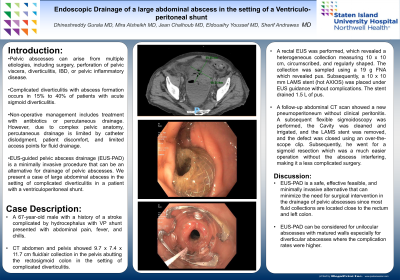Tuesday Poster Session
Category: Endoscopy Video Forum
P3226 - Endoscopic Drainage of a Large Abdominal Abscess in the Setting of a Ventriculo-Peritoneal Shunt

- DG
Dhineshreddy Gurala, MD
Staten Island University Hospital, Northwell Health
Staten Island, New York
Presenting Author(s)
Staten Island University Hospital, Northwell Health, Staten Island, NY
Introduction:
Pelvic abscesses can arise from multiple etiologies, including surgery, perforation of pelvic viscera, diverticulitis, IBD, or pelvic inflammatory disease. Complicated diverticulitis with abscess formation occurs in 15% to 40% of patients with acute sigmoid diverticulitis. Non-operative management includes treatment with antibiotics or percutaneous drainage. However, due to complex pelvic anatomy, percutaneous drainage is limited by catheter dislodgment, patient discomfort, and limited access points for fluid drainage. EUS-guided pelvic abscess drainage (EUS‐PAD) is a minimally invasive procedure that can be an alternative for drainage of pelvic abscesses. We present a case of large abdominal abscess in the setting of complicated diverticulitis in a patient with a ventriculoperitoneal shunt.
Case Description/Methods:
A 67-year-old male with a history of a stroke complicated by hydrocephalus with VP shunt presented with abdominal pain, fever, and chills. CT abdomen and pelvis showed 9.7 x 7.4 x 11.7 cm fluid/air collection in the pelvis abutting the rectosigmoid colon in the setting of complicated diverticulitis. A Consultation was requested to drain the abscess endoscopically given the VP shunt. A rectal EUS was performed, which revealed a heterogeneous collection measuring 10 x 10 cm, circumscribed, and regularly shaped. The collection was sampled using a 19 g FNA which revealed pus. Subsequently, a 10 x 10 mm LAMS stent (hot AXIOS) was placed under EUS guidance without complications. The stent drained 1.5 L of pus. A follow-up abdominal CT scan showed a new pneumoperitoneum without clinical peritonitis. A subsequent flexible sigmoidoscopy was performed, the Cavity was cleaned and irrigated, and the LAMS stent was removed, and the defect was closed using an over-the-scope clip. Subsequently, he went for a sigmoid resection which was a much easier operation without the abscess interfering, making it a less complicated surgery.
Discussion:
EUS-PAD is a safe, effective feasible, and minimally invasive alternative that can minimize the need for surgical intervention in the drainage of pelvic abscesses since most fluid collections are located close to the rectum and left colon. EUS-PAD can be considered for unilocular abscesses with matured walls especially for diverticular abscesses where the complication rates were higher.
Disclosures:
Dhineshreddy Gurala, MD, Mira AlSheikh, MD, Jean Chalhoub, MD, Youssef El Douaihy, MD, Sherif Andrawes, MD. P3226 - Endoscopic Drainage of a Large Abdominal Abscess in the Setting of a Ventriculo-Peritoneal Shunt, ACG 2023 Annual Scientific Meeting Abstracts. Vancouver, BC, Canada: American College of Gastroenterology.
